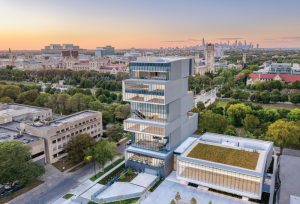The David Rubenstein Forum at the University of Chicago is a new center for intellectual exchange, scholarly collaboration, and special events. The 97,000-square-foot facility consists of a 2-story podium and a 10-story tower of stacked “neighborhoods” with a zinc-and-glass exterior. A 285-seat auditorium sits above the podium, and a large multipurpose space on the 2nd Floor, called the University Room, can accommodate groups of up to 600 people. The top of the tower features a flat-floor multipurpose space and offers stunning views of the campus, the Midway Plaisance, the city skyline, and Lake Michigan.

At 166 feet tall, the Forum rises over 100 feet above the surrounding tree line, striking a dynamic form that symbolically ties together the history of Chicago’s Midway Plaisance, the University’s heritage and ambitions, and the architectural legacy of the area. Conceived as a scholarly retreat, the design promotes openness and diverse interactions, from the mixed program at the base to the serene City View Room on the 10th Floor.
The stacked neighborhoods of the tower are staggered to varying degrees, posing a complex structural challenge, with cantilevers up to 40 feet. The structural system is composed of a series of simple individual structural elements stacked in a harmonious form to efficiently create the desired open spaces. Incorporating post-tensioned concrete into the structural design proved crucial to achieving the long spans, cantilevers, and column-free spaces that the architectural team envisioned.
Several core design principles informed the structural systems of the David Rubenstein Forum, the key to helping meet the University of Chicago’s and the Architect’s goals for the project. These included:
- Openness to capture views of the University, of the Chicago skyline, and Lake Michigan and allow for free stacking of the “neighborhoods” and flexibility of event planning, without the need for expensive structural transfers.
- Simple Use of Familiar Materials enables the efficient construction of conventional structural elements and technologies commonly used in the Chicago concrete market.
- Unique Form to “stitch” the north and south sides of Chicago together while simultaneously taking advantage of the prominent site location on the Midway Plaisance to create a highly visible landmark.
- Balance to achieve the cantilevers to the north and south while minimizing the structural work required in the building’s interior core.
The innovation of the structure lies in its simplicity. The efficient form also made it cost-effective, utilizing common materials and systems that could be constructed in a familiar manner.
The main support for the Tower is provided by a pair of 12-inch-thick, conventionally reinforced concrete side walls that are skewed from neighborhood to neighborhood. These side walls, and the slabs that are connected to them, form a stiff box-like structure that cantilevers out to the north and south by as much as 40 feet. The back-and-forth cantilevers are balanced to help minimize the amount of bending induced into the building’s central core, enabling the use of thin 8-inch-thick shear walls around the elevators and egress stairs, where space is limited, and coordination of systems is critical. Four rectangular concrete columns also support the slabs, which are located just outside of the central core to preserve the open concept.
An unbonded post-tensioning system is used in the floor slabs, which form the top and bottom of the stacked boxes, to enable the long, column-free 65-foot spans and reduce the tensile stresses in the top of the cantilevered boxes. These long, column-free spans are an essential component of the functionality of the building, maintaining openness throughout. The typical slab thickness is 10 inches and is only thickened where needed, such as where the side walls are skewed and do not align from the floor above to the floor below and at interior-to-exterior transitions. The result is a long-span slab that is efficiently constructed with simple, flat formwork that allows for a more efficient distribution of ductwork due to no interior beams.
Additionally, the structural design took advantage of the high-strength concretes available in the Chicago construction market. All concrete used in the superstructure has a compressive strength of 8,000 psi or higher. In addition to using high strength concretes, the modulus of elasticity and a low 28-day drying shrinkage limit were specified to minimize the likelihood of developing restraint-to-shortening cracking due to the robust side walls and additional rebar placed in the slabs along the walls. The General Contractor and Concrete Contractor were involved early in a design-assist phase, together with input from the post-tensioning supplier, to recommend ways to simplify the construction of the concrete structure.
As with the Tower, the principle of openness remained key at the Podium. However, the clear open span over the University Room is 105 feet, compared with the 65-foot clear spans in the Tower. The design uses steel roof trusses, which in turn rest upon, and are transferred by, a system of cantilevered post-tensioned slabs and beams at Level 2 to accomplish this span. To allow for a high ceiling at the interface with the façade, the trusses are set back from the south edge of the University Room, which also requires the steel roof beams to cantilever from the trusses.■
